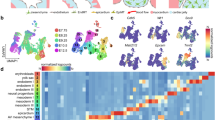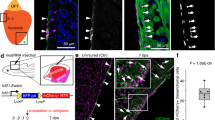Abstract
Heart disease is the leading cause of mortality and morbidity in the western world. The heart has little regenerative capacity after damage, leading to much interest in understanding the factors required to produce new cardiac myocytes. Despite a robust understanding of the molecular networks regulating cardiac differentiation1,2, no single transcription factor or combination of factors has been shown to activate the cardiac gene program de novo in mammalian cells or tissues. Here we define the minimal requirements for transdifferentiation of mouse mesoderm to cardiac myocytes. We show that two cardiac transcription factors, Gata4 and Tbx5, and a cardiac-specific subunit of BAF chromatin-remodelling complexes, Baf60c (also called Smarcd3), can direct ectopic differentiation of mouse mesoderm into beating cardiomyocytes, including the normally non-cardiogenic posterior mesoderm and the extraembryonic mesoderm of the amnion. Gata4 with Baf60c initiated ectopic cardiac gene expression. Addition of Tbx5 allowed differentiation into contracting cardiomyocytes and repression of non-cardiac mesodermal genes. Baf60c was essential for the ectopic cardiogenic activity of Gata4 and Tbx5, partly by permitting binding of Gata4 to cardiac genes, indicating a novel instructive role for BAF complexes in tissue-specific regulation. The combined function of these factors establishes a robust mechanism for controlling cellular differentiation, and may allow reprogramming of new cardiomyocytes for regenerative purposes.
This is a preview of subscription content, access via your institution
Access options
Subscribe to this journal
Receive 51 print issues and online access
$199.00 per year
only $3.90 per issue
Buy this article
- Purchase on Springer Link
- Instant access to full article PDF
Prices may be subject to local taxes which are calculated during checkout




Similar content being viewed by others
References
Olson, E. N. Gene regulatory networks in the evolution and development of the heart. Science 313, 1922–1927 (2006)
Srivastava, D. Making or breaking the heart: from lineage determination to morphogenesis. Cell 126, 1037–1048 (2006)
Lickert, H. et al. Baf60c is essential for function of BAF chromatin remodelling complexes in heart development. Nature 432, 107–112 (2004)
Simone, C. et al. p38 pathway targets SWI-SNF chromatin-remodeling complex to muscle-specific loci. Nature Genet. 36, 738–743 (2004)
Lessard, J. et al. An essential switch in subunit composition of a chromatin remodeling complex during neural development. Neuron 55, 201–215 (2007)
Lange, M. et al. Regulation of muscle development by DPF3, a novel histone acetylation and methylation reader of the BAF chromatin remodeling complex. Genes Dev. 22, 2370–2384 (2008)
Wu, J. I., Lessard, J. & Crabtree, G. R. Understanding the words of chromatin regulation. Cell 136, 200–206 (2009)
Creemers, E. E. et al. Coactivation of MEF2 by the SAP domain proteins myocardin and MASTR. Mol. Cell 23, 83–96 (2006)
Saga, Y. et al. MesP1 is expressed in the heart precursor cells and required for the formation of a single heart tube. Development 126, 3437–3447 (1999)
David, R. et al. MesP1 drives vertebrate cardiovascular differentiation through Dkk-1-mediated blockade of Wnt-signalling. Nature Cell Biol. 10, 338–345 (2008)
Bondue, A. et al. Mesp1 acts as a master regulator of multipotent cardiovascular progenitor specification. Cell Stem Cell 3, 69–84 (2008)
Lindsley, R. C. et al. Mesp1 coordinately regulates cardiovascular fate restriction and epithelial-mesenchymal transition in differentiating ESCs. Cell Stem Cell 3, 55–68 (2008)
Kinder, S. J. et al. The orderly allocation of mesodermal cells to the extraembryonic structures and the anteroposterior axis during gastrulation of the mouse embryo. Development 126, 4691–4701 (1999)
Pevny, L. et al. Erythroid differentiation in chimaeric mice blocked by a targeted mutation in the gene for transcription factor GATA-1. Nature 349, 257–260 (1991)
Laugwitz, K. L. et al. Islet1 cardiovascular progenitors: a single source for heart lineages? Development 135, 193–205 (2008)
Black, J. C. et al. A mechanism for coordinating chromatin modification and preinitiation complex assembly. Mol. Cell 23, 809–818 (2006)
Cirillo, L. A. et al. Opening of compacted chromatin by early developmental transcription factors HNF3 (FoxA) and GATA-4. Mol. Cell 9, 279–289 (2002)
Lupien, M. et al. FoxA1 translates epigenetic signatures into enhancer-driven lineage-specific transcription. Cell 132, 958–970 (2008)
Schultheiss, T. M., Burch, J. B. & Lassar, A. B. A role for bone morphogenetic proteins in the induction of cardiac myogenesis. Genes Dev. 11, 451–462 (1997)
Marvin, M. J. et al. Inhibition of Wnt activity induces heart formation from posterior mesoderm. Genes Dev. 15, 316–327 (2001)
Reiter, J. F. et al. Gata5 is required for the development of the heart and endoderm in zebrafish. Genes Dev. 13, 2983–2995 (1999)
Brons, I. G. et al. Derivation of pluripotent epiblast stem cells from mammalian embryos. Nature 448, 191–195 (2007)
Tesar, P. J. et al. New cell lines from mouse epiblast share defining features with human embryonic stem cells. Nature 448, 196–199 (2007)
Small, E. M. et al. Myocardin is sufficient and necessary for cardiac gene expression in Xenopus . Development 132, 987–997 (2005)
Latinkic, B. V., Kotecha, S. & Mohun, T. J. Induction of cardiomyocytes by GATA4 in Xenopus ectodermal explants. Development 130, 3865–3876 (2003)
Zhao, R. et al. Loss of both GATA4 and GATA6 blocks cardiac myocyte differentiation and results in acardia in mice. Dev. Biol. 317, 614–619 (2008)
Davis, R. L., Weintraub, H. & Lassar, A. B. Expression of a single transfected cDNA converts fibroblasts to myoblasts. Cell 51, 987–1000 (1987)
Xie, H. et al. Stepwise reprogramming of B cells into macrophages. Cell 117, 663–676 (2004)
Zhou, Q. et al. In vivo reprogramming of adult pancreatic exocrine cells to β-cells. Nature 455, 627–632 (2008)
Yamamoto, M. et al. Nodal antagonists regulate formation of the anteroposterior axis of the mouse embryo. Nature 428, 387–392 (2004)
Acknowledgements
We thank K. Koshiba-Takeuchi for assistance with immunohistochemistry, H. Ogawa for advice on chromatin immunoprecipitation, B. L. Black and D. Srivastava for discussions and expression constructs, G. R. Crabtree, M. Nemer, E. N. Olson and Y. Saga for expression constructs, and G. Howard and S. Ordway for editorial assistance. This work was supported by Human Frontiers Science Program CDA and short-term fellowships (J.K.T.), MEXT’s program for young independent researchers (J.K.T.), Mitsubishi Foundation (J.K.T.), the Takeda Science Foundation (J.K.T.) and NHLBI (R01HL085860, B.G.B.). This work was also supported by an NIH/NCRR grant (C06 RR018928, J. David Gladstone Institutes) and by William H. Younger, Jr (B.G.B.).
Author Contributions J.K.T. performed all experimental work. J.K.T. and B.G.B. conceived the study. B.G.B. directed the study and wrote the paper.
Author information
Authors and Affiliations
Corresponding authors
Ethics declarations
Competing interests
The authors have applied for a patent based on the work described in this paper.
Additional information
The authors declare competing financial interests: details accompany the full-text HTML version of the paper at http://www.nature.com/nature.
Supplementary information
Supplementary Information
This file contains Supplementary Figures 1-2 with Legends and Full Legends for Supplementary Movies 1 and 2. (PDF 3508 kb)
Supplementary Movie 1
This movies shows ectopic beating tissue in E8.0 embryos transfected with Tbx5/Gata4/Nkx2-5+Baf60c (see file s1 for full legend). (MOV 3959 kb)
Supplementary Movie 2
This movie shows ectopic beating tissue in E8.0 embryos transfected with Tbx5/Gata4+Baf60c (see file s1 for full legend. (MOV 9552 kb)
Rights and permissions
About this article
Cite this article
Takeuchi, J., Bruneau, B. Directed transdifferentiation of mouse mesoderm to heart tissue by defined factors. Nature 459, 708–711 (2009). https://doi.org/10.1038/nature08039
Received:
Accepted:
Published:
Issue Date:
DOI: https://doi.org/10.1038/nature08039
This article is cited by
-
Recent advances and future prospects in direct cardiac reprogramming
Nature Cardiovascular Research (2023)
-
The second heart field: the first 20 years
Mammalian Genome (2023)
-
Exposure of embryos to phenanthrene impacts the cardiac development in F1 zebrafish larvae and potential reasons
Environmental Science and Pollution Research (2023)
-
Lamin A/C-dependent chromatin architecture safeguards naïve pluripotency to prevent aberrant cardiovascular cell fate and function
Nature Communications (2022)
-
COMPASS and SWI/SNF complexes in development and disease
Nature Reviews Genetics (2021)
Comments
By submitting a comment you agree to abide by our Terms and Community Guidelines. If you find something abusive or that does not comply with our terms or guidelines please flag it as inappropriate.



